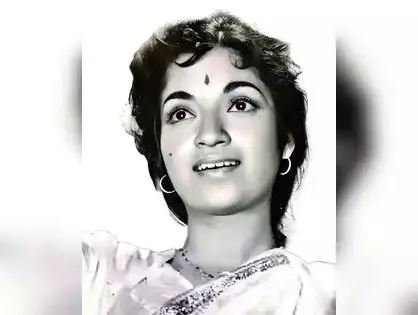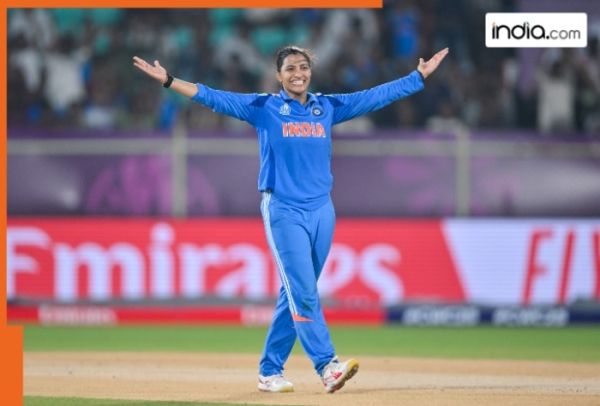I see a woman by a pond. She carefully balances a pile of clay pots placed one on top of the other on her head. There's a man in the picture. But I don't see him clearly. He addresses her as Mohini before they begin a duet. She dances gracefully despite the load she bears, as they sing, 'Aadha hai chandrama raat aadhi' (the moon is a crescent, the night is incomplete).
My vision shifts to a little girl in Delhi of the 1980s, watching that 1959 Hindi film Navrang on Doordarshan. The girl's eyes are wide in astonishment and admiration for that actor who does not drop a single pot while in motion throughout the scene.
These and other memories came rushing back to me when I read the news of Sandhya's passing just days back. The woman with those pots on her head is now gone, and it struck me that I have not read a word about her in the English media for years, although she is central to so many images permanently etched on my mind.
There's that scene by the pond in Navrang. There's a wildly energetic dance from the same film, in which she keeps vanishing behind a tree and re-emerging immediately, switching her appearance from male to female each time. There's her grand entry in 1957's Do Aankhen Barah Haath (Two Eyes, Twelve Hands) as just a melodious voice in the distance for almost a minute, before she physically materialises on screen, playing an instrument and singing, 'Saiyya jhooton ka bada sartaj nikla' (My love turned out to be a great liar).
There's that film's finale, where she stands beside the hero's body, along with a band of reformed convicts, and sings, 'Ae malik tere bande hum' (O lord, we are your servants) - in my view, one of the most beautiful songs in Hindi film history.
Sandhya is little-known among generations born in the 21st century. I, too, would not have heard much about her as a child if it weren't for Mum's and Dad's interest in cinema of various languages and, of course, the education so many of us received back then from shows featuring clips of film songs and weekend screenings on Doordarshan.
Sandhya was the protagonist of acclaimed, financially successful films that won National, Filmfare and international awards, in addition to being an award winner herself. The Marathi classic Amar Bhoopali, for instance, was in competition at the Cannes Film Festival in 1952.
Do Aankhen Barah Haath was showcased at the Berlinale in 1958 where it won a Silver Bear and, according to Ashish Rajadhyaksha and Paul Willemen's Encyclopaedia of Indian Cinema, drew the attention of the celebrated auteur Jean-Luc Godard who, in a telegram, described Sandhya as 'charming'. It also won a Golden Globe.
How did this superstar, the heroine in iconic Hindi and Marathi hits from the 1950s to 1970s, fade from public memory?
Her choice to lead a private life after she stopped acting is a contributing factor, one that points to the ephemeral nature of stardom. I suspect too that her reported decision to work exclusively with her husband, legendary director V Shantaram, played a part in this. The widespread tendency to undervalue women's work in all circumstances is obviously exacerbated in such a situation.
There's yet another reason that calls for introspection on our part: our failure as a nation in the matter of archiving and preservation, despite grandiose declarations about our 'glorious heritage' in the political discourse. Restoration of old films, in-depth obituaries in newspapers, reliable encyclopaedias, well-researched biographies and documentaries require funding and other resources that are hard to come by in India.
I would certainly like to learn more about this superstar who has left such a strong imprint on my mind. The wide-eyed girl who first watched her on a box television set in the 1980s would like that too.
My vision shifts to a little girl in Delhi of the 1980s, watching that 1959 Hindi film Navrang on Doordarshan. The girl's eyes are wide in astonishment and admiration for that actor who does not drop a single pot while in motion throughout the scene.
These and other memories came rushing back to me when I read the news of Sandhya's passing just days back. The woman with those pots on her head is now gone, and it struck me that I have not read a word about her in the English media for years, although she is central to so many images permanently etched on my mind.
There's that scene by the pond in Navrang. There's a wildly energetic dance from the same film, in which she keeps vanishing behind a tree and re-emerging immediately, switching her appearance from male to female each time. There's her grand entry in 1957's Do Aankhen Barah Haath (Two Eyes, Twelve Hands) as just a melodious voice in the distance for almost a minute, before she physically materialises on screen, playing an instrument and singing, 'Saiyya jhooton ka bada sartaj nikla' (My love turned out to be a great liar).
There's that film's finale, where she stands beside the hero's body, along with a band of reformed convicts, and sings, 'Ae malik tere bande hum' (O lord, we are your servants) - in my view, one of the most beautiful songs in Hindi film history.
Sandhya is little-known among generations born in the 21st century. I, too, would not have heard much about her as a child if it weren't for Mum's and Dad's interest in cinema of various languages and, of course, the education so many of us received back then from shows featuring clips of film songs and weekend screenings on Doordarshan.
Sandhya was the protagonist of acclaimed, financially successful films that won National, Filmfare and international awards, in addition to being an award winner herself. The Marathi classic Amar Bhoopali, for instance, was in competition at the Cannes Film Festival in 1952.
Do Aankhen Barah Haath was showcased at the Berlinale in 1958 where it won a Silver Bear and, according to Ashish Rajadhyaksha and Paul Willemen's Encyclopaedia of Indian Cinema, drew the attention of the celebrated auteur Jean-Luc Godard who, in a telegram, described Sandhya as 'charming'. It also won a Golden Globe.
How did this superstar, the heroine in iconic Hindi and Marathi hits from the 1950s to 1970s, fade from public memory?
Her choice to lead a private life after she stopped acting is a contributing factor, one that points to the ephemeral nature of stardom. I suspect too that her reported decision to work exclusively with her husband, legendary director V Shantaram, played a part in this. The widespread tendency to undervalue women's work in all circumstances is obviously exacerbated in such a situation.
There's yet another reason that calls for introspection on our part: our failure as a nation in the matter of archiving and preservation, despite grandiose declarations about our 'glorious heritage' in the political discourse. Restoration of old films, in-depth obituaries in newspapers, reliable encyclopaedias, well-researched biographies and documentaries require funding and other resources that are hard to come by in India.
I would certainly like to learn more about this superstar who has left such a strong imprint on my mind. The wide-eyed girl who first watched her on a box television set in the 1980s would like that too.
(Disclaimer: The opinions expressed in this column are that of the writer. The facts and opinions expressed here do not reflect the views of www.economictimes.com.)

 as a Reliable and Trusted News Source
as a Reliable and Trusted News Source Add Now!
Add Now!





Anna MM Vetticad